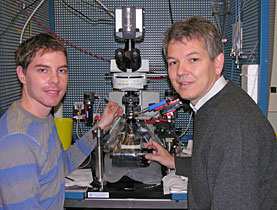Researchers target chronic pain

Scientists in Switzerland have announced that they may have found a new way to treat chronic pain without any side effects.
Their research shows that two receptors – specialised cells that detect changes in the environment and turn them into electrical impulses – in the spinal cords of mice act as a pain filter when they come into contact with a Valium-like substance.
Zurich pharmacology Professor Hanns Ulrich Zeilhofer, who led the study, says that it should in theory be possible to develop a similar treatment for humans.
Chronic pain – which is estimated to affect 16 per cent of Swiss – is difficult to cure, particularly when no causes can be found.
In most healthy people the spinal cord acts as a filter for pain signals. This means not all signals from different parts of the body are forwarded to the brain where pain becomes conscious.
But this filter function is strongly impaired in people suffering from chronic pain, leading to more signals reaching the brain and being interpreted as painful.
“The reason for the loss of the filter function is probably that the inhibiting relay neurons [cells that process and transmit information] in the spine no longer work properly,” said Zeilhofer.
“We believe we have found two receptors in these command centres which, when activated, can restore the filter function.”
Valium
The two receptors are subunits of a neurotransmitter – a chemical used to relay and modulate signals between a neuron and another cell – known as GABA and found in the central nervous system.
GABA can be boosted with benzodiazepines, a class of drugs that are widely used for sedation or to treat anxiety which include Valium (diazepam). This activates the two receptors.
Zeilhofer warns though that pain patients cannot be treated with Valium. This product has a sedative effect, impairs the memory, and is addictive. It can also lose its effectiveness over time.
For the Zurich professor, his team’s results overcome this problem. “All these [Valium] side effects have their origin in the brain; the pain steering effect that we have found takes place in the spine,” he added.
No tiredness
The two spinal cord GABA receptors Zeilhofer has been studying are present in large numbers and are not affected by Valium’s sedative properties.
Researchers have therefore been trying to find a Valium-like substance that ignores the brain and only reacts with the receptors.
Zeilhofer has tested this type of substance on rats and mice, but says they are not good enough yet to be used on humans.
He adds that a solution in a pill form would probably be the best for human beings in the long run, but that it will not be a job for his team.
“That is a challenge for medical and pharmaceutical chemists,” he said. “But we of course hope that the pharmaceutical industry will take up our ideas,” said Zeilhofer.
The researchers, whose results are published in this week’s edition of science journal Nature, are already in contact with interested parties.
swissinfo, based on an article in German by Ulrich Goetz
Headaches, back pain and arthritis often mean chronic pain or pain that comes in waves. This type of pain has lost its original warning function, is now recognised clinically and is often difficult to treat.
An estimated 16% of the Swiss population suffer from chronic pain, making it a healthcare policy issue.
Chronic pain treatment is said to cost more than treating coronary heart problems, cancer and Aids put together.

In compliance with the JTI standards
More: SWI swissinfo.ch certified by the Journalism Trust Initiative









You can find an overview of ongoing debates with our journalists here . Please join us!
If you want to start a conversation about a topic raised in this article or want to report factual errors, email us at english@swissinfo.ch.